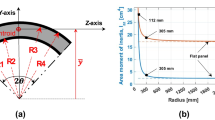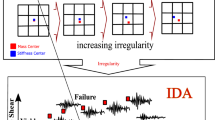Abstract
The present study investigates the performance of steel structures plagued with plan irregularities subjected to underground blast-induced excitations. The building plan irregularity is considered by comparing the structural performance of various geometrical shape buildings, namely square, rectangle, L shape and C shape. The blast load is calculated by considering constant blast charge weight and varying the standoff distance. The study installs resilient control systems, namely fluid viscous dampers and X-plate dampers within the selected eleven storey steel buildings. An analytical approach is adopted to investigate the efficiency of passive control techniques with the help of finite element programme. A parametric study is also carried to determine the most efficient damper properties and damper type in improving the performance of steel buildings. Three damper placement techniques are also evaluated such as zig–zag pattern, alternate floor damper placement and dampers at all locations to optimize the number of dampers in achieving the maximum reduction in structural responses. The study concludes that the fluid viscous and X-plate dampers yield a maximum reduction in top storey peak displacement at a standoff distance of 400 m in the range 58% and 88%, respectively. The study also reports that the viscous damper and X-Plates prove to be an efficient passive control technique for irregular shaped steel buildings as compared to regular shaped buildings.














Similar content being viewed by others
Data availability
The data used to support the findings of this study are included within the article.
Abbreviations
- \(\ddot{{\varvec{x}}}\) g :
-
Blast-induced ground acceleration
- v :
-
Peak particle velocity
- t a :
-
Time of arrival
- R :
-
Standoff distance
- c :
-
Wave propagation velocity of soil
- f c :
-
Uniaxial compression strength of rock particles
- SD:
-
Scaled distance
- Q :
-
Charge mass
- F :
-
Damping force
- C :
-
Damping coefficient
- V :
-
Velocity of piston
- α :
-
Damping exponent
- A 1, A 2, A 3, A 4, A 5 :
-
Type of group A dampers
- B 1, B 2, B 3, B 4, B 5 :
-
Type of group B dampers
- E :
-
Modulus of elasticity
- σ y :
-
Yield Stress
- H :
-
Strain hardening rate
- t :
-
Thickness of X-plate damper
- b :
-
Breadth of triangular portion (X-plate damper)
- a :
-
Height of triangular portion (X-plate damper)
- n :
-
Yielding exponent
- k d :
-
Effective stiffness of XPD
- E y :
-
Yield force of XPD
- q :
-
Yielding displacement in XPD
- FVD:
-
Fluid viscous damper
- XPD:
-
X-plate damper
- RCC:
-
Reinforced cement concrete
References
Gardner L (2019) August). Stability and design of stainless-steel structures—review and outlook. Thin-Walled Struct 141:208–216. https://doi.org/10.1016/j.tws.2019.04.019
Sabuwala T, Linzell D, Krauthammer T (2005) Finite element analysis of steel beam to column connections subjected to blast loads. Int J Impact Eng 31(7):861–876. https://doi.org/10.1016/j.ijimpeng.2004.04.013
Landolfo R (2019) Lightweight steel framed systems in seismic areas: current achievements and future challenges. Thin Walled Struct 140:114–131. https://doi.org/10.1016/j.tws.2019.03.039
MacRae GA, Clifton GC (2015). Research on seismic performance of steel structures. In steel innovations conference, Auckland, New Zealand
Specification, A. I. S. C. (2005). Specification for structural steel buildings. ANSI/AISC, 36010
National Research Council. (2000). Blast mitigation for structures: 1999 status report on the DTRA/TSWG Program. National Academies Press
Weli SS, Vigh LG (2022) Blast performance of steel frames equipped with NiTi SMA bolts: design procedure and numerical evaluation. J Struct Eng. https://doi.org/10.1061/(asce)st.1943-541x.0003314
Kou S, Zhang X, Li W, Song C (2022) Dynamic response parameter analysis of steel frame joints under blast loading. Buildings 12(4):433. https://doi.org/10.3390/buildings12040433
Lavendra S, Kumar P, Raghavendra T (2021) Progressive collapse behaviour assessment of steel frame structures—a review. In: IOP conference series: earth and environmental science, 822(1), 012004. https://doi.org/10.1088/1755-1315/822/1/012004
Diaz EEM, Moreno FN, Mohammadi J (2009) Investigation of Common Causes of Bridge Collapse in Colombia. Pract Period Struct Des Constr 14(4):194–200. https://doi.org/10.1061/(asce)sc.1943-5576.0000006
Naji A, Irani F (2012) Progressive collapse analysis of steel frames: Simplified procedure and explicit expression for dynamic increase factor. Int J Steel Struct 12(4):537–549
Ebrahimi V, Baniotopoulos C (2017) Numerical studies on the effect of plan irregularities in the progressive collapse of steel structures. Struct Infrastruct Eng 13(12):1576–1583. https://doi.org/10.1080/15732479.2017.1303842
Nawar MT, Arafa IT, Elhosseiny OM (2022) Numerical damage evaluation of perforated steel columns subjected to blast loading. Def Technol 18(5):735–746. https://doi.org/10.1016/j.dt.2021.03.019
Abdel Raheem SE, Ahmed MM, Ahmed MM, Abdel-Shafy AG (2018) Seismic performance of L-shaped multi-storey buildings with moment-resisting frames. Proc Inst Civ Eng Struct Build 171(5):395–408. https://doi.org/10.1680/jstbu.16.00122
Abdel Raheem SE, Ahmed MM, Ahmed MM, Abdel-shafy AG (2018) Evaluation of plan configuration irregularity effects on seismic response demands of L-shaped MRF buildings. Bull Earthq Eng 16(9):3845–3869. https://doi.org/10.1007/s10518-018-0319-7
Pirizadeh M, Shakib H (2013) Probabilistic seismic performance evaluation of non-geometric vertically irregular steel buildings. J Constr Steel Res 82:88–98. https://doi.org/10.1016/j.jcsr.2012.12.012
Tremblay R, Poncet L (2005) Seismic performance of concentrically braced steel frames in multistory buildings with mass irregularity. J Struct Eng 131(9):1363–1375. https://doi.org/10.1061/(ASCE)0733-9445(2005)131:9(1363)
Gerami M, Sharbati Y, Sivandi-Pour A (2013) Nonlinear seismic vulnerability evaluation of irregular steel buildings with cumulative damage indices. Int J Adv Struct Eng 5(1):1–15. https://doi.org/10.1186/2008-6695-5-9
Homaei F (2017) Soil-structure interaction effects on demand and probabilistic confidence level of geometric vertically irregular steel buildings. Modares Civ Eng J 16(20):215–229
Webster AC, Vaicaitis R (1992) Application of tuned mass dampers to control vibrations of composite floor systems. Eng J Am Inst Steel Construct 29(3):116–124
Nielsen EJ, Lai ML, Soong TT, Kelly JM (1996) Viscoelastic damper overview for seismic and wind applications. In: smart structures and materials 1996: passive damping and isolation (Vol. 2720, pp. 138–144). SPIE
Cherry S, Filiatrault A (1993) Seismic response control of buildings using friction dampers. Earthq Spectra 9(3):447–466
Symans MD, Madden GJ, Wongprasert N (2000) Experimental study of an adaptive base isolation system for buildings. In Proc of 12th World Conf. on Earthquake Eng., 12WCEE
Constantinou MC, Symans MD (1992) Experimental and analytical investigation of seismic response of structures with supplemental fluid viscous dampers. National center for earthquake engineering research, buffalo, NY, pp 1–25
Dyke SJ, Spencer BF Jr, Sain MK, Carlson JD (1998) An experimental study of MR dampers for seismic protection. Smart Mater Struct 7(5):693
Inoue, Y. (1992). State of the art report of active and hybrid control research in Japan. In proceedings of the tenth world conference on earthquake engineering.
Fisco NR, Adeli H (2011) Smart structures: part I—active and semi-active control. Scientia Iranica 18(3):275–284
Coffield A, Adeli H (2016) Irregular steel building structures subjected to blast loading. J Civ Eng Manag 22(1):17–25
Kangda MZ, Bakre S (2020) Performance evaluation of moment-resisting steel frame buildings under seismic and blast-induced vibrations. J Vib Eng Technol 8(1):1–26
Kangda MZ (2022) Blast protection techniques: a review. Arch Comput Methods Eng. https://doi.org/10.1007/s11831-021-09704-5
Pujari, N. N. (2011). Optimization of X-plate dampers for seismic response control of steel framed buildings (Doctoral dissertation, Visvesvaraya National Institute of Technology)
IS 875 (Part-I) Bureau of Indian standards 1987 code of practice for design loads (other than earthquake) for buildings and structures: dead loads-unit weights of building materials and stored materials (Second Revision). UDC 624.042: 006.76
IS 875 (Part-II) Bureau of Indian standards 1987 code of practice for design loads for buildings and structures: imposed loads (Second Revision). UDC 624.042.3: 006.76
BIS (2016) IS 1893 (part 1): 2016: Indian standard Criteria for Earthquake Resistant Design of Structures, Part 1: general provisions and buildings (Sixth Revision). Bureau of Indian Standards, New Delhi
Narkhede DI, Sinha R (2014) Behavior of nonlinear fluid viscous dampers for control of shock vibrations. J Sound Vib 333(1):80–98. https://doi.org/10.1016/j.jsv.2013.08.041
Mondal PD, Ghosh A, Chakraborty S (2014) Fluid viscous damper in mitigation of structural vibration effect due to underground blast. Int J Mater Struct Integr 8(4):273–290
Bakre S, Jangid R, Reddy G (2006) Optimum X-plate dampers for seismic response control of piping systems. Int J Press Vessels Pip 83(9):672–685. https://doi.org/10.1016/j.ijpvp.2006.05.003
Kangda MZ, Bakre S (2019) Response control of adjacent structures subjected to blast-induced vibrations. Proc Inst Civ Eng Struct Build 172(12):902–921
Kumar R, Choudhury D, Bhargava K (2016) Determination of blast-induced ground vibration equations for rocks using mechanical and geological properties. J Rock Mech Geotech Eng 8(3):341–349. https://doi.org/10.1016/j.jrmge.2015.10.009
Kangda MZ, Bakre S (2021) Performance of linear and nonlinear damper connected buildings under blast and seismic excitations. Innov Infrastruct Solut 6(2):1–19
IS: 800–2007. General construction in steel-code of practice. Bureau of Indian Standard, New Delhi
Funding
No external funding agencies funded the project.
Author information
Authors and Affiliations
Corresponding author
Ethics declarations
Conflicts of interest
The authors declare that they have no conflicts of interest.
Rights and permissions
Springer Nature or its licensor (e.g. a society or other partner) holds exclusive rights to this article under a publishing agreement with the author(s) or other rightsholder(s); author self-archiving of the accepted manuscript version of this article is solely governed by the terms of such publishing agreement and applicable law.
About this article
Cite this article
Raikar, R.G., Kangda, M.Z. Effect of plan irregularity on the performance of steel buildings subjected to blast-induced vibrations. Innov. Infrastruct. Solut. 8, 77 (2023). https://doi.org/10.1007/s41062-023-01034-8
Received:
Accepted:
Published:
DOI: https://doi.org/10.1007/s41062-023-01034-8




